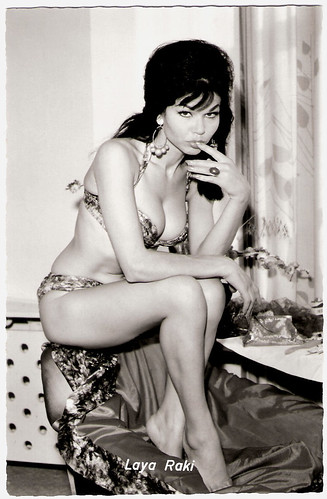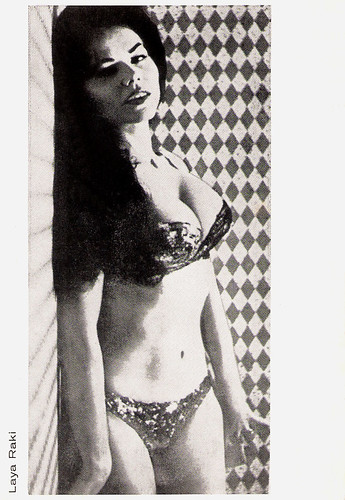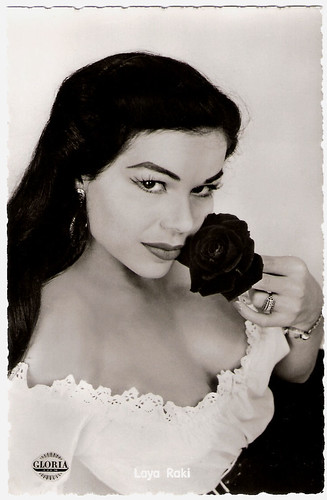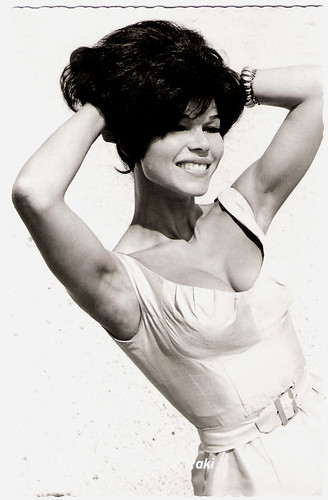Exotic dancer and film actress Laya Raki (1927) was a popular sex symbol in Germany during the 1950’s. She appeared in revealing outfits in films and on photos, and captured men's attention like no other German showgirl. Later she also became an international star with her roles in British films and TV productions.
![Laya Raki]()
Austrian postcard by HDH-Verlag (Verlag Hubmann), Wien (Vienna). Photo: Joe Niczky, München (Munich) / Ufa.
![Laya Raki]()
German postcard by Kolibri-Verlag G.m.b.H., Minden/Westf., no 1637.
![Laya Raki]()
Vintage postcard.
Erotic Radiance
Laya Raki was born Brunhilde Marie Alma Herta Jörns in Calvörde near Helmstedt, Germany, in 1927. Her parents were acrobat Maria Althoff and her partner, acrobat and clown Wilhelm Jörns. As she was an admirer of the famous dancer La Jana and liked to drink raki, she assumed the stage name Laya Raki. She attracted attention for the first time in 1947-1950 as a glamour dancer (in German: Schönheitstänzerin) in Frankfurt and other German cities. When she performed in Berlin, her star began to rise: her 38-23-36 figure and erotic radiance became the talk of the town. Film company DEFA engaged her for a small role as a rumba dancer in Der Rat der Götter/The Council of the Gods (1950, Kurt Maetzig), which won two awards. The Berliner Morgenpost reported that she was a great dancer with an expressive face, rich in nuances. That same year the press department of Realfilm presented her as their new discovery in Die Dritte von rechts/The Third from the Right (1950, Géza von Cziffra). It was a rather boring revue film, but the highlight was the scene in which the scantily clad Raki (with only two white stars on her nipples) exposed herself to the lustful gazes of the cinema audiences. In 1953, she danced in Ehe für eine Nacht/Marriage for One Night (1953, Viktor Tourjansky), and in Die Rose von Stambul/The Rose of Stamboul (1953, Karl Anton) Austrian actor Paul Hörbiger wanted to marry her upon seeing her dancing.
![Laya Raki]()
German postcard by Kolibri-Verlag G.m.b.H., Minden/Westf., no 2556. Photo: Sascha-Lux-Gloria-Film / Niczky. Publicity still for Roter Mohn/Red Poppy (1956, Franz Antel).
![Laya Raki]()
German postcard by Kolibri-Verlag G.m.b.H., Minden/Westf., no 1775.
![Laya Raki]()
German postcard by WS-Druck, Wanne-Eickel, no. 142. Photo: Sascha-Lux-Gloria-Film / Niczky.
Lured by a Swindler
In 1954 Laya Raki was lured to London by 'Major' Howard Rowson, a swindler with empty promises of film roles in the United Kingdom and Hollywood. Her unemployed situation made headlines that opened opportunities quickly. The J. Arthur Rank Film Company, which needed a slightly exotic type for a film in New Zealand, received her with open arms. They gave her the role of the seductive wife of a Maori chieftain's in The Seekers (1954, Ken Annakin) with Jack Hawkins and Glynis Johns. She created a worldwide stir by baring her breasts. Next she played in the comedy Up to His Neck (1954, John Paddy Carstairs) and in the adventure film Quentin Durward (1955, Richard Thorpe) starring Robert Taylor. She also appeared in German productions like Am Anfang war es Sünde/The Beginning Was Sin (1954, Frantisek Cáp) with Viktor Staal, and Die Frau des Botschafters/The Ambassador's Wife (1955, Hans Deppe) with Ingrid Andree. In the Heimatfilm Roter Mohn/Red Poppy (1956, Franz Antel) she played the gypsy girl Ilonka and conducted refreshing dialogues with famous Viennese comic Hans Moser. After some acting lessons in Hollywood, she appeared in several British TV productions, including 39 episodes of the series Crane (1962-1965). She played Moroccan dancer and bartender Halima, the partner of smuggler Richard Crane (Patrick Allen). In the meantime she modeled for postcards, pin-up photos and magazines all over the world. In 1962, she recorded the songs Faire l`amour and the twist song Oh Johnny hier nicht parken (Oh, Johnny don´t park here). The latter was banned by a Nuremberg court who thought her ecstatic moaning was imitating coitus. She continued to play in German films, including the Krimis Die Nylonschlinge/Nylon Noose (1963, Rudolf Zehetgruber) with Dietmar Schönherr, and Das Haus auf dem Hügel/The House on the Hill (1964, Werner Klingler) starring Australian actor Ron Randell. She also appeared with him in her last film, Savage Pampas (1966, Hugo Fregonese) starring Robert Taylor. In 1957, Laya Raki had married Randell in London. “He is the best and most beautiful man of the world”, she told the press, and she remained at his side until his death in 2005.
![Laya Raki]()
German postcard by ISV, no. C 10. Photo: Sascha-Lux / Gloria / Grein.
A British Pathé news item about the Earl´s Court Motor Show of 1964 with Lay Raki in a mink bikini seated on an Aston Martin. Source: British Pathé.
Sources: Glamour Girls of the Silver Screen, Wikipedia, and IMDb.

Austrian postcard by HDH-Verlag (Verlag Hubmann), Wien (Vienna). Photo: Joe Niczky, München (Munich) / Ufa.

German postcard by Kolibri-Verlag G.m.b.H., Minden/Westf., no 1637.

Vintage postcard.
Erotic Radiance
Laya Raki was born Brunhilde Marie Alma Herta Jörns in Calvörde near Helmstedt, Germany, in 1927. Her parents were acrobat Maria Althoff and her partner, acrobat and clown Wilhelm Jörns. As she was an admirer of the famous dancer La Jana and liked to drink raki, she assumed the stage name Laya Raki. She attracted attention for the first time in 1947-1950 as a glamour dancer (in German: Schönheitstänzerin) in Frankfurt and other German cities. When she performed in Berlin, her star began to rise: her 38-23-36 figure and erotic radiance became the talk of the town. Film company DEFA engaged her for a small role as a rumba dancer in Der Rat der Götter/The Council of the Gods (1950, Kurt Maetzig), which won two awards. The Berliner Morgenpost reported that she was a great dancer with an expressive face, rich in nuances. That same year the press department of Realfilm presented her as their new discovery in Die Dritte von rechts/The Third from the Right (1950, Géza von Cziffra). It was a rather boring revue film, but the highlight was the scene in which the scantily clad Raki (with only two white stars on her nipples) exposed herself to the lustful gazes of the cinema audiences. In 1953, she danced in Ehe für eine Nacht/Marriage for One Night (1953, Viktor Tourjansky), and in Die Rose von Stambul/The Rose of Stamboul (1953, Karl Anton) Austrian actor Paul Hörbiger wanted to marry her upon seeing her dancing.

German postcard by Kolibri-Verlag G.m.b.H., Minden/Westf., no 2556. Photo: Sascha-Lux-Gloria-Film / Niczky. Publicity still for Roter Mohn/Red Poppy (1956, Franz Antel).

German postcard by Kolibri-Verlag G.m.b.H., Minden/Westf., no 1775.

German postcard by WS-Druck, Wanne-Eickel, no. 142. Photo: Sascha-Lux-Gloria-Film / Niczky.
Lured by a Swindler
In 1954 Laya Raki was lured to London by 'Major' Howard Rowson, a swindler with empty promises of film roles in the United Kingdom and Hollywood. Her unemployed situation made headlines that opened opportunities quickly. The J. Arthur Rank Film Company, which needed a slightly exotic type for a film in New Zealand, received her with open arms. They gave her the role of the seductive wife of a Maori chieftain's in The Seekers (1954, Ken Annakin) with Jack Hawkins and Glynis Johns. She created a worldwide stir by baring her breasts. Next she played in the comedy Up to His Neck (1954, John Paddy Carstairs) and in the adventure film Quentin Durward (1955, Richard Thorpe) starring Robert Taylor. She also appeared in German productions like Am Anfang war es Sünde/The Beginning Was Sin (1954, Frantisek Cáp) with Viktor Staal, and Die Frau des Botschafters/The Ambassador's Wife (1955, Hans Deppe) with Ingrid Andree. In the Heimatfilm Roter Mohn/Red Poppy (1956, Franz Antel) she played the gypsy girl Ilonka and conducted refreshing dialogues with famous Viennese comic Hans Moser. After some acting lessons in Hollywood, she appeared in several British TV productions, including 39 episodes of the series Crane (1962-1965). She played Moroccan dancer and bartender Halima, the partner of smuggler Richard Crane (Patrick Allen). In the meantime she modeled for postcards, pin-up photos and magazines all over the world. In 1962, she recorded the songs Faire l`amour and the twist song Oh Johnny hier nicht parken (Oh, Johnny don´t park here). The latter was banned by a Nuremberg court who thought her ecstatic moaning was imitating coitus. She continued to play in German films, including the Krimis Die Nylonschlinge/Nylon Noose (1963, Rudolf Zehetgruber) with Dietmar Schönherr, and Das Haus auf dem Hügel/The House on the Hill (1964, Werner Klingler) starring Australian actor Ron Randell. She also appeared with him in her last film, Savage Pampas (1966, Hugo Fregonese) starring Robert Taylor. In 1957, Laya Raki had married Randell in London. “He is the best and most beautiful man of the world”, she told the press, and she remained at his side until his death in 2005.

German postcard by ISV, no. C 10. Photo: Sascha-Lux / Gloria / Grein.
A British Pathé news item about the Earl´s Court Motor Show of 1964 with Lay Raki in a mink bikini seated on an Aston Martin. Source: British Pathé.
Sources: Glamour Girls of the Silver Screen, Wikipedia, and IMDb.